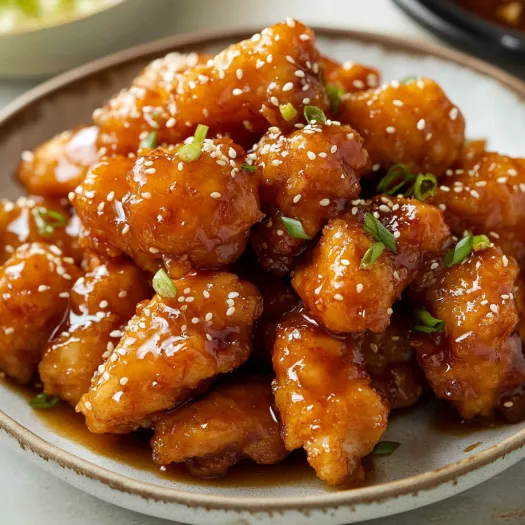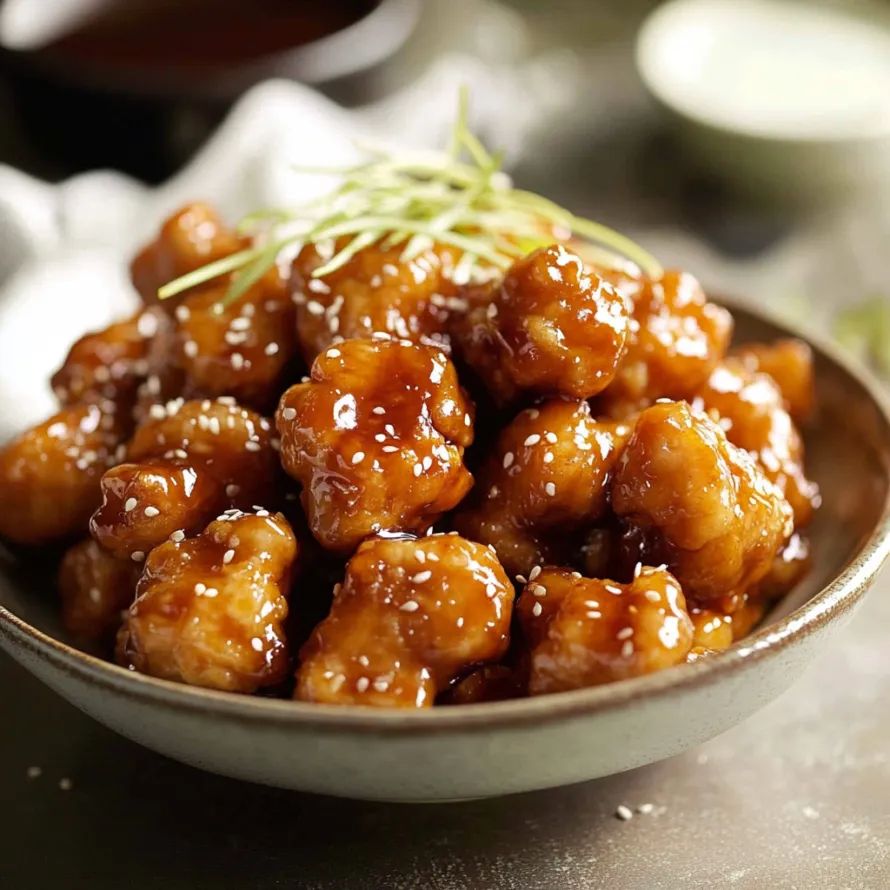 Pin
Pin
My family can't get enough of this Crunchy Honey Chicken - our perfect answer to Asian takeout cravings right at home. What makes this special? The two-stage coating and frying method creates pieces that stay super crunchy for hours, even when covered in that rich honey glaze.
After trying countless recipes that turned soggy once sauced, I spent years mixing different Asian cooking approaches. This version finally nails that long-lasting crunch my family always wanted but I couldn't quite deliver.
Ingredients
- Chicken thighs: Chopped into 1" chunks stay juicy through the double-frying process
- Light soy sauce: Gives the right amount of salt without overwhelming everything else
- Chinese cooking wine: Adds that authentic flavor dimension regular homemade versions miss
- Cornflour: The key to that amazing crunchy outer layer that won't go soft in sauce
- Cold soda water: Creates an incredibly airy batter for maximum crunch factor
- Baking powder: Forms countless tiny bubbles in the coating for extra crispiness
- Glucose or corn syrup: Turns the sauce into a shell-like coating that sticks to rather than soaks the crunchy exterior
- Rice vermicelli noodles: Create an impressive crunchy bed for serving
Step-by-Step Instructions
- Marinate the Chicken:
- Mix your chicken bits with soy sauce, Chinese cooking wine and cornflour, then pop in the fridge for half an hour. This quick soak adds flavor while the cornflour helps everything else stick better later.
- Dust with Cornflour:
- Toss chicken pieces in cornflour until they're fully covered, then shake off what doesn't stick. This first layer builds the foundation for our super-crunchy double coating.
- Prepare Cold Batter:
- Mix cornflour, flour, baking powder and salt in a cold bowl. Pour in chilled soda water and stir just 10 times. Your batter should coat the chicken nicely without being transparent or too thick. Keeping everything cold is the secret to amazing crunch.
- First Fry:
- Drop your coated chicken into 180°C oil and cook about 3 minutes until pale gold. This first cooking sets the outer layer and starts building crunchiness. Do small batches so the oil stays hot.
- Rest and Cool:
- Let chicken cool on a rack for 20 minutes. This waiting step actually strengthens the coating and gets it ready for the final fry that makes it super crunchy.
- Make Honey Sauce:
- Cook honey, glucose or corn syrup, soy sauce and Chinese wine for 3 minutes until it's like maple syrup. Using glucose instead of water creates a sauce that sticks to the outside without making it soggy.
- Second Fry:
- Heat oil to 200°C and fry chicken again for just 90 seconds until golden brown. This second fry creates that thick, sturdy crust that won't get soft for hours, even after adding sauce.
- Toss and Serve:
- Quickly mix chicken in warm honey sauce and serve right away over crunchy noodles. Moving fast keeps the sauce from getting too thick as it cools.

I can't stress enough how much difference the glucose or corn syrup makes. I watched so many restaurant cooks making crispy sauced dishes and noticed they all used some type of invert sugar to create that candy-shell effect. When I finally tried this at home, my family couldn't believe the chicken stayed crunchy even hours after dinner.
Storage Tips
Want to prep ahead and still get that fresh-made taste? Completely double-fry your chicken, cool it on a rack, and stick it in the fridge. Make your sauce separately and refrigerate too. When you're ready to eat, heat the chicken at 180°C for 7 minutes until hot and crunchy, then quickly toss with rewarmed sauce.
If you store chicken that's already mixed with sauce and try to reheat it, it'll definitely turn soft, no matter how you warm it up. Always keep your chicken and sauce separate for the best results.
You can use your oil two more times since chicken doesn't leave a strong flavor. Just let it cool, strain it through a paper towel in a colander, and save it for your next frying project.
Substitution Guide
You can swap in chicken breast or tenderloin instead of thighs, but add a tiny pinch (1/8 teaspoon) of baking soda to the marinade to keep it tender and don't marinate longer than recommended.
No soda water? Regular ice water works too, but your chicken won't stay crunchy as long after adding sauce. It'll still taste amazing if you eat it within 20 minutes.
If you want something less sweet, try adding 2 tablespoons of apple cider vinegar and a splash of hot sauce to balance the honey. Let it simmer one extra minute before using. This creates a different but more complex flavor mix.
You can use either glucose or corn syrup in this recipe - they work the same way. If you don't have either, more honey will do the job but won't protect against sogginess quite as well.

Recipe Q&A
- → How does double frying make the chicken crispier?
Two rounds of frying gets rid of extra moisture in the coating. This builds a thicker crust that stays crispy longer. It also makes sure your chicken is hot and cooked just right.
- → Why use cold soda water in the batter?
The cold fizzy water helps make a fluffy batter that expands nicely during frying. This gives you a crunchier finish that doesn't soak up too much oil.
- → What keeps the honey sauce from soaking into the chicken?
The trick is adding glucose or corn syrup. This makes the sauce more like candy that sticks to the outside without turning your crunchy chicken soft.
- → Can I substitute chicken thighs with another cut?
You can definitely use chicken breast or tenderloin. Just add a tiny bit of baking soda to soften them up, but don't let them sit in the marinade too long.
- → How can I make this dish ahead of time?
Fry the chicken twice, cool it down, and store in the fridge. When you're ready, warm it in the oven at 180°C/350°F to get it crunchy again. Heat the honey sauce on its own, then mix everything together and serve.
- → Can I use an air fryer or oven instead of frying?
This recipe works best with deep frying because you need that instant high heat to set the batter quickly. Air fryers and ovens just can't get the same super crunchy coating.
